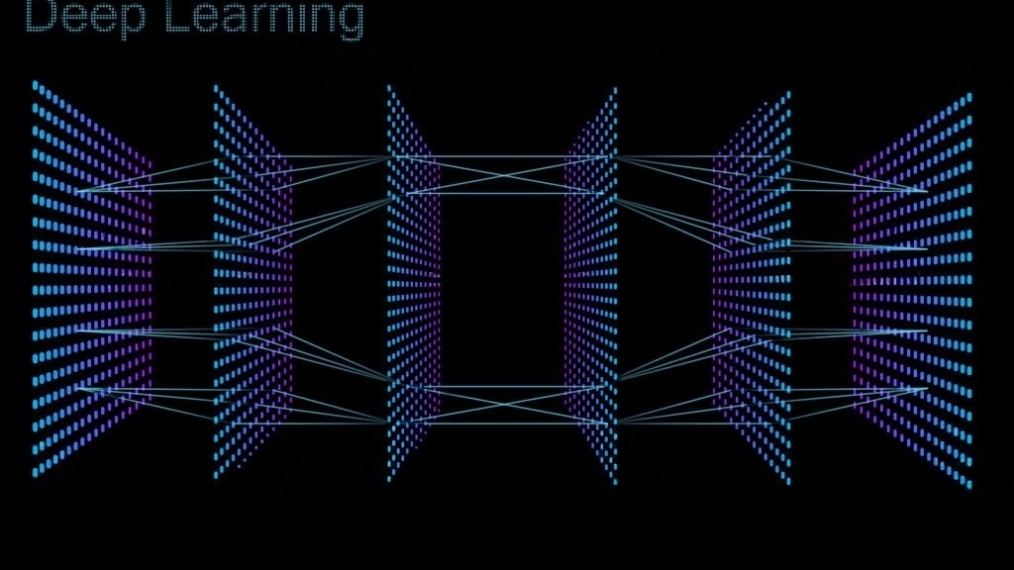Welcome to this executive briefing on Deep Learning.
Your time is your most asset, which is why this article will only cover the ultimate essentials for you to get up to speed with deep learning and see tangible examples of how this technology can add substantial value to your business.
Here’s how this course is structured:
- First, we will talk about what deep learning is and why it has such a high potential to disrupt virtually any business and any industry
- Then we will discuss how a deep learning neural network is built, setting up a framework for the algorithm to do the rest of the work
- Then we will dive into how to combine deep learning with other areas of artificial intelligence, such as reinforcement learning, computer vision and natural language processing
- Finally, we will look at ten different case studies of deep learning already being applied in different companies and industries.
Here we are after the real results, the numbers, so we can get a feel for what deep learning can do for our businesses. I hope you’re as excited as I am about upcoming tutorials.
And without further ado, let’s dive into the world of deep learning.
Table of Contents
- What is Deep Learning?
- What is Deep Neural Network?
- Building Neural Networks?
- How Neural Network Learn
- Deep Learning and Other areas of AI
- 10 Use-cases – with Real Results
- Summary
What is Deep Learning?
Deep learning is a family of machine learning methods based on artificial neural networks. There’s two parts of this definition.
First, it’s very interesting to point out that machine learning is defined as a discipline within artificial intelligence (AI), that teaches computers how to make predictions based on data.
Therefore, if we combine these definitions, we can see that this is artificial intelligence, machine learning and deep learning below.

Next, what I would like to talk about is the part of the definition that states artificial neural networks, the human brain is the most sophisticated system for data analysis that we humans have ever discovered and that we are aware of.
Therefore, it’s understandable that we wanted to create something similar inside of our computers. Computer scientists have found a way to mimic the human brain inside machines.
Computer scientists have created a machine brain, but it is not as advanced as a human brain and lacks general intelligence. Nevertheless, specific applications like self-driving cars and cancer detection have seen great success through deep learning.
So what sets deep learning apart from standard methods of analysis or even from machine learning?
Well, the main difference is that in deep learning there is no predefined framework
For non-deep learning methods, we try various frameworks to fit our data and understand patterns. If one works, we use it, otherwise we keep trying until we find a suitable framework.
Deep learning, on the other hand, involves simply using a deep neural network with multiple layers, without any pre-defined framework.
What is Deep Neural Network?
It’s an artificial construct designed to mimic how the human brain works.
A deep neural network is like a brain without a pre-set framework. Just as a child learns through experience and interaction with the world, a deep neural network learns by processing data.
An example of this is teaching the network to distinguish between dogs and cats by providing it with thousands of images of both. With this data, the network can learn without any further input.
Deep learning works by observing patterns in data and determining features on its own, such as cats having pointy ears and dogs having fluffy ears. However, it requires a large amount of data, potentially thousands or hundreds of thousands of examples, to truly learn. Despite this drawback, the benefits of deep learning can be substantial in some cases.
Also, Handwritten text recognition using traditional machine learning algorithms only achieves an accuracy of around 87%, rarely exceeding 90%. With deep learning, it’s common to achieve a 99% accuracy rate due to its strength.
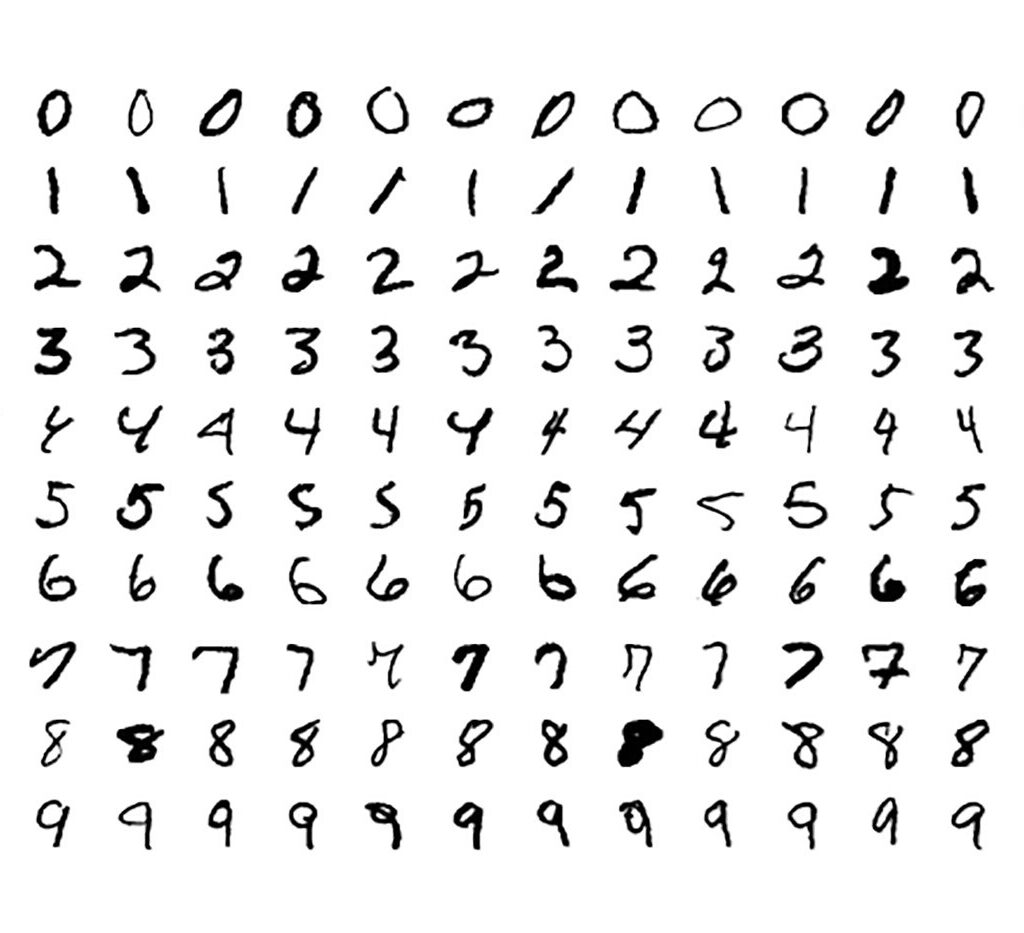
Deep learning has been around since the 80s but was not widely adopted until recent advancements in computing power. The theoretical concepts of deep learning are well established but were forgotten until recent technological advancements made it possible to put them into practice.
Recently, deep learning has started to rise again because computing power has risen substantially.
So that’s, in a nutshell, is what deep learning is.
We could talk much more about this topic, but hopefully this gives you a quick overview of how this branch of machine learning is different and why it is so powerful.
Building Neural Networks?
So if deep learning algorithms learn on their own, then why do we need data scientists or machine learning engineers to build them in the first place?
And why are experts in the space so expensive and hard to find?
These are great questions, and to answer them, we need to take a little bit of a closer look at neural networks
We see an example of an input output type of neural network.
It has one input layer with 2 neurons and one output layer with just 1 neuron.
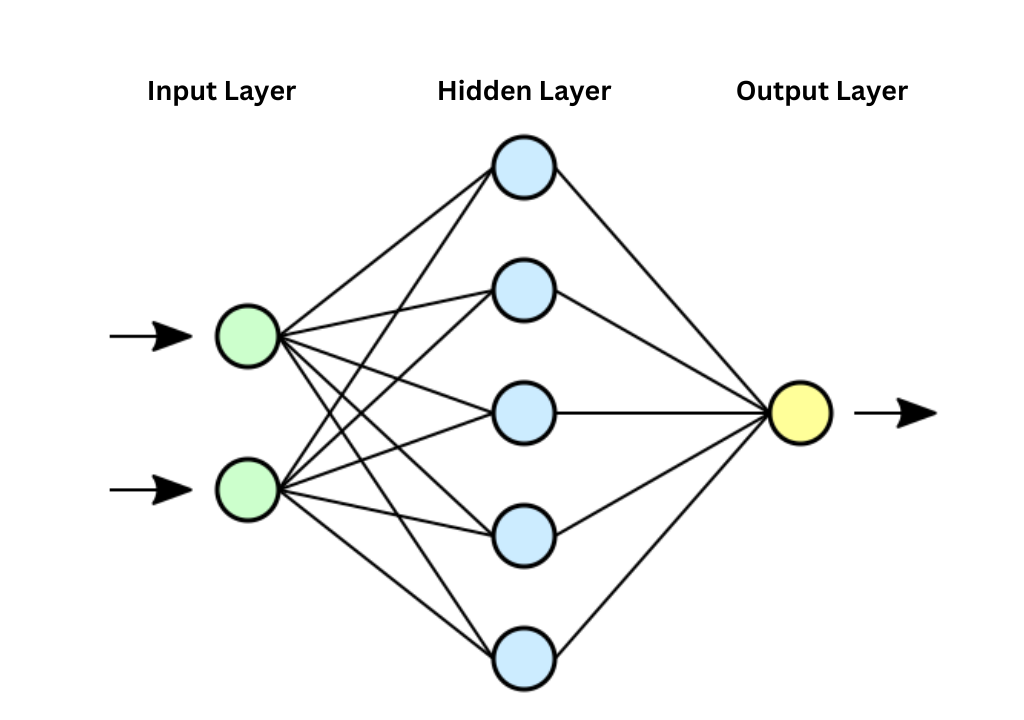
Now, what we can do is add another layer in between the input and output layers. This layer is going to be called a hidden layer and in this case it has five neurons.
We can add another hidden layer and another hidden layer and keep adding hidden layers as much as we want.
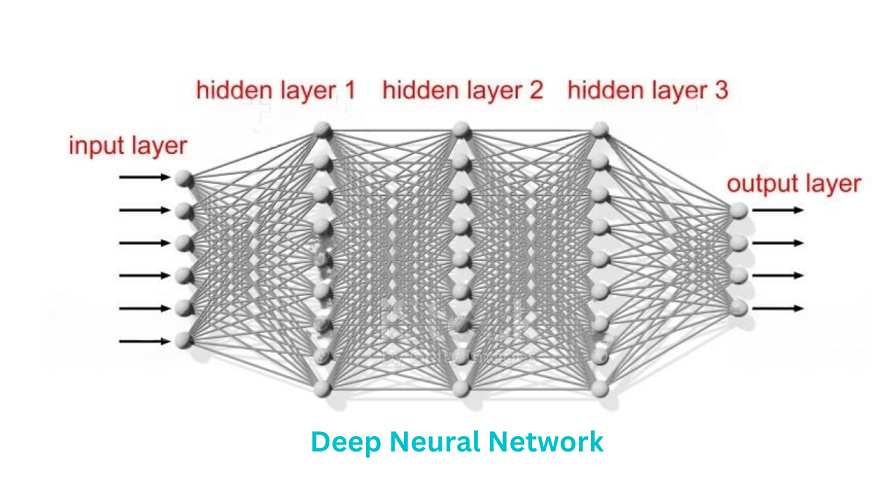
And that makes this neural network a deep neural network.
These different ways that neural networks can be constructed are called architectures. Every purpose, every application, every challenge will have a different architecture that serves the best.
Architecture is actually a very creative process, and that’s why expert machine learning engineers and data scientists who build deep learning algorithms are in such high demand and are so expensive to have on your team because they are doing highly creative work, which requires their unique touch and input.
And once the suitable architecture is set up, the algorithm will do the rest of the work on its own and continue learning how to finalize and do that task that it’s designed to do.
How Neural Network Learn
So neural networks are extremely technical, extremely complex, but nevertheless, the principles,
the intuition behind them is quite simple.
And that’s what we’re going to uncover today
So let’s imagine that we have a neural network with an input layer of four neurons, a hidden layer of five neurons and an output layer of one year.
- The way neural networks work is that they have memory and the memory is effectively weighted within these neurons
- Every neuron has a certain weight that can be adjusted and that’s what it all is about
- When you hear the term neural networks are being trained, what is being trained are the weights in this neural network and the weights affect how the calculations between neurons perform
- Basically the input layer is used as a weighted sum in each one of these neurons in the middle there
And that’s how the middle layer neurons are calculated, and the weights is what we can adjust and then the final output layer is a way to add some of the neurons in the middle.
When you have an input, when you’re performing the learning part of training a neural network, you have lots of supervised data, for instance, images of dogs and cats.
So what you would do is you would input the images of your dogs and cats into the input layer as a vectorized form of the image.
An image is converted to numbers, input into a neural network, and the network outputs a label (dog or cat). If the output matches the actual result, the weights are adjusted, if not, the network adjusts its weights through backpropagation. This process requires a large amount of data for accuracy.
To train up a neural network because this is quite a lengthy process and it’s iterative. So it needs to learn over time, that’s how the weights within a neural network are adjusted.
The same type of approach can be used to other examples:
- Analyse customer data, you can input your customer demographics, their affinity to purchase their geolocation, their preferences, their recent purchase history
- You can use that for training and once you’ve tailored your neural network, in the end you’ll have a neural network designed to predict customer churn
- You could use the same in real estate to predict property value based on number of rooms, location, how many car spaces it has and so on
- You can design a neural network pretty much for any application where you have some inputs and you want to predict something
Deep Learning and Other areas of AI
Other areas of artificial intelligence, such as reinforcement learning, natural language processing and computer vision represent some of the most disruptive exponential technologies currently in existence.
So what happens when we combine them with deep learning? What does that even mean?
We can see that artificial intelligence encapsulates machine learning and machine learning encapsulates those three technologies.
Now, if we add deep learning to the diagram, we’ll see that it doesn’t necessarily encapsulate these 3 technologies fully. What we can see is that while these technologies exist within the domain of artificial intelligence and machine learning, they don’t fully fall into deep learning.
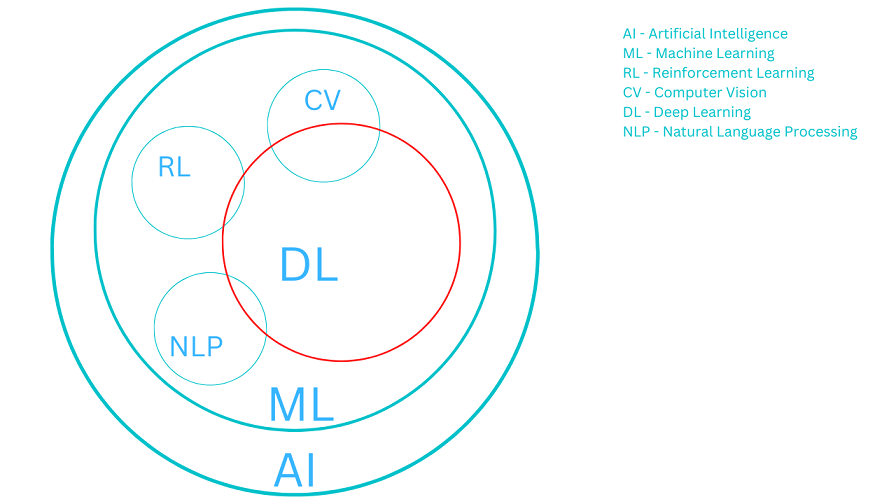
And this is already a very important point, that computer vision, natural language processing and reinforcement learning don’t always require deep learning to function.
However, when we do our deep learning to these technologies, what that means is that we’re essentially adding the power of deep neural networks to those technologies.
- If it’s reinforcement learning, it becomes deep reinforcement learning,
- If it’s computer vision, it becomes deep computer vision
- If its natural language processing, it becomes deep natural language processing or deep NLB, as usual, with neural networks.
This approach has the drawback of more costly computation.
However, if the computing power is available, then often, adding a deep neural network can substantially improve accuracy of the algorithms simply because now it has additional room to think and experiment with different neural pathways.
It’s important to note that this is not a silver bullet to solve all problems. However, it does tend to work in most cases.
Therefore, it can be useful to keep in mind that you can often add learning to another exponential technology to enhance it.
10 Use-cases – with Real Results
Uses Deep Learning Insights for cancer detection with almost 10 million deaths per year.
- Cancer is the second leading cause of death in the world after cardiovascular disease
- In addition to the trauma and suffering, it also causes over a trillion dollars of economic damage worldwide. The biggest contributor to successful treatment is early and correct diagnosis
- But even after years of study and specialization, pathologists disagree on the diagnosis in over 50% of cases of breast and prostate cancer
- Google worked on a large data set to develop a deep learning algorithm that can properly identify metastases with 89% accuracy, compared to 73% for a trained pathologist with unlimited time, although unlikely to replace them at any time soon, the system can significantly help pathologists improve their diagnoses
Spotify
Uses deep learning in their recommendation engine.
- The online streaming service already accounts for 75% of the music industry revenue, with 3.4 billion dollars of revenue in 2013
- Streaming services have stopped relying solely on organic searches long ago, and recommendations based on previous purchases are a classic way of driving business
- Spotify as a recommendation engine Discover Weekly looks at the over 2 billion playlists and compares that to a user’s listening habits
- Deep learning algorithms detect patterns within the vast amount of data to find users with similar music taste further, improving the selection
- The new recommendation system helped Spotify increase its number of active users from 75 to 100 million, despite fierce competition from Apple Music
Goldspot Discoveries
Uses deep learning in mineral exploration.
- The Earth’s non-renewable natural resources are getting harder and harder to find
- Companies looking for profitable operations need to dig deeper and cover more area, both of which are costly and time consuming
- Major gold discoveries have dropped from around 15 per year in the 90s to just 1 or 2 per year in recent years, despite exploration spending and double or even tripling during that same period
- Utilizing deep learning to analyse existing geological data, Goldspot discoveries developed a predictive method for finding gold deposits
- They were able to correctly identify 86 percent of existing gold deposits in cubic BTB, despite working of data from just four percent of the total surface area
Digital Domain
Uses deep learning for visual effects.
- Visual effects are used in almost everything that hits our screens, from blockbuster movies to everyday commercials
- In blockbuster movies, they can represent between 20 to 50 percent of the whole movie budget, which can mean up to one hundred million dollars for the largest productions
- Digital Domain works on the character Thallus in Avengers and Game, using a deep learning algorithm trained on high-res scans of the actors face to render the character in real time
- This gave the director unprecedented insight into how the movie will look during the actual shooting rather than days or weeks later
- Critical acclaim and public opinion about how natural the visual effects are powered the movie to become the highest earning movie of all time, earning almost three billion dollars worldwide
Ayasdi
Uses deep learning in anti money laundering.
- Money laundering transactions are estimated to total one to two trillion dollars annually, an incredible 2% to 5% of the global GDP
- Preventing money laundering also helps stop terrorism, human trafficking, and the distribution of narcotics and unnamed financial institution
- One of the largest in the world worked with Acidy to integrate a deep learning solution and prevent money laundering
- The goal was to increase operational efficiency by 3%
- The bank achieved a reduction in investigative volume of over 20 percent, as well as lowered them regulatory exposure by discovering a new risk segment
Deep Instinct
Uses deep learning for cybersecurity
- Cybercrime costs the global economy 600 billion dollars every year
- Hackers are already using completely autonomous robots to try and find ways into systems in minutes rather than hours, and traditional security measures simply aren’t keeping up
- An unnamed Fortune 500 company installed deep instinct’s deep learning powered security platform
- Within the first week of deployment, the algorithm found twelve infected endpoints and with time found that almost 10 percent of their devices were infected, even though they had all been equipped with traditional security measures before
- Despite requiring less than one percent of CPU usage, it tested ninety nine percent successful at finding and preventing incoming malware, including one hundred and forty cases of ransomware
Doxel
Uses deep learning for productivity tracking.
- Around 80% of construction projects are delivered over budget, with typical delivery times, 20 months behind schedule
- Part of the reason is that project managers lack a realistic instant visibility of the project’s progress
- Most progress tracking is still done with physical measurement, visual inspection, and clipboards. This is part of the reason why construction efficiency has only increased by around one percent during the last twenty years, whereas manufacturing efficiency
- Almost doubled in the same period, Doxel uses deep learning to analyse data collected from robots and drones that traverse a construction site
- This can detect deviations from the planned schedule and prompt the project team to act before delays start to pile up
- During one project, labour productivity was increased by 38 percent and the project was delivered 11% under budget
Amazon Rekognition
Uses deep learning in facial recognition
- Although facial recognition is currently under scrutiny due to allegations of bias and concerns over individual safety
- The technology is still in its infancy stages and experiencing fast development
- It has numerous applications and as a society, we will need to find out which ones of them are acceptable to us and which ones aren’t
- Washington County jail management uploaded all three hundred thousand mugshots they had previously taken since 2001 into the system later, when a crime was captured on camera, rather than manually scanning the vast set of mug shots in the hopes of finding a match, recognition was able to find matches with 8% or 95% were even higher similarities
- This has allowed law enforcement officers to quickly narrow their search and follow up on leads, often solving cases before any additional problems arose
Zestimate
Uses deep learning for real estate prices.
- The real estate market is the largest sector of the U.S. economy, surpassing thirty percent of the total GDP
- Opportunities as well as competition are vast and real estate agencies are turning to artificial intelligence to handle them
- The current shortage of appraisers has increased the time and cost of accurately predicting the price of a property system
- It uses a deep learning algorithm to analyse home characteristics, their unique features and on and off market data to predict the price of almost one hundred million homes in the US
- Their median error for listed properties is only one point nine percent, allowing real estate agencies who use their service to focus on customer acquisition and retention rather than costly and time-consuming appraisals
Zest Finance
Uses deep learning for loan approval.
- 7 million people in the U.S., around 5% of the auto lenders are currently at least 3 months behind their car payments
- This is powered both by customers that don’t account for their own financial capabilities and by companies taking greater risks to try and improve their revenue
- This finance offers a deep learning algorithm that analyses a potential customer’s credit score and determines their risk of defaulting
- This allowed a top US auto lender to cut its losses by 23% annually
So there we go with top 10 deep learning use cases.
Those were ten examples of deep learning and action bringing tangible results to businesses already today.
I hope this inspires some ideas of how you can use deep learning in your industry and in your business.
Summary
So in a nutshell,
Deep learning has been a game-changer in the field of artificial intelligence, revolutionizing the way machines can learn from data. The ability of deep learning algorithms to learn patterns and make predictions has opened up new avenues in areas such as image and speech recognition, natural language processing, and robotics.
In 2012, the state-of-the-art image recognition system was able to identify objects in images with an accuracy of about 60%. By 2020, deep learning algorithms had improved this accuracy to over 95%, demonstrating just how rapidly the technology is advancing.
As the technology continues to evolve and improve, we can expect to see deep learning being integrated into a wide range of industries and playing a crucial role in solving some of the world’s most complex problems. With the rapid advancements in computing power, data storage, and algorithms, the future of deep learning looks extremely promising, and we can expect to see it making an even greater impact in the years to come.
So, there we go.
I really hope that now you are much more comfortable and confident speaking about deep learning and more importantly, seeing how you can apply them in your industry and in your business.
Thank you for reading our blog, we hope you found the information provided helpful and informative. We invite you to follow and share this blog with your colleagues and friends if you found it useful.
Share your thoughts and ideas in the comments below. To get in touch with us, please send an email to dataspaceconsulting@gmail.com or contactus@dataspacein.com.
You can also visit our website – DataspaceAI
